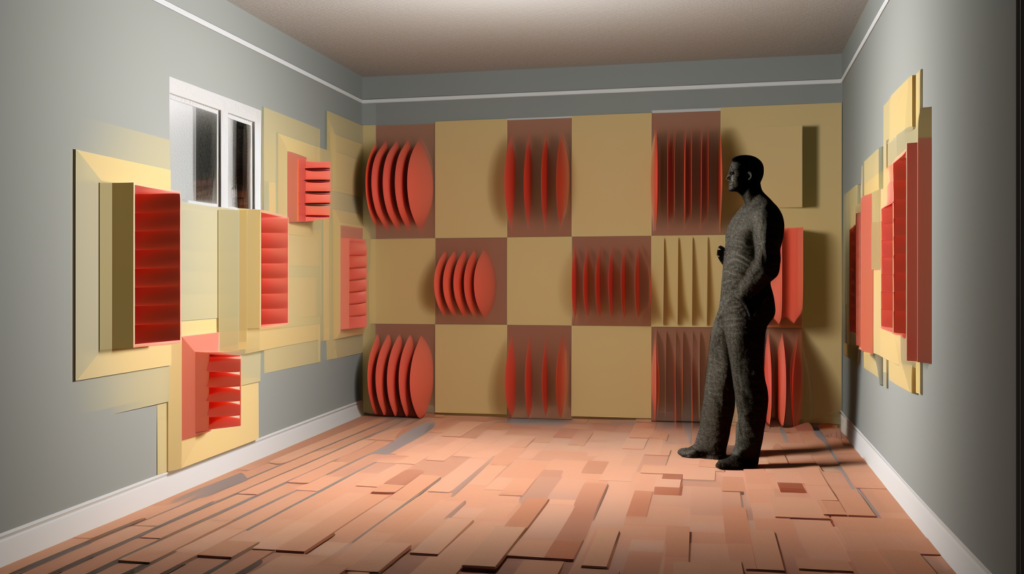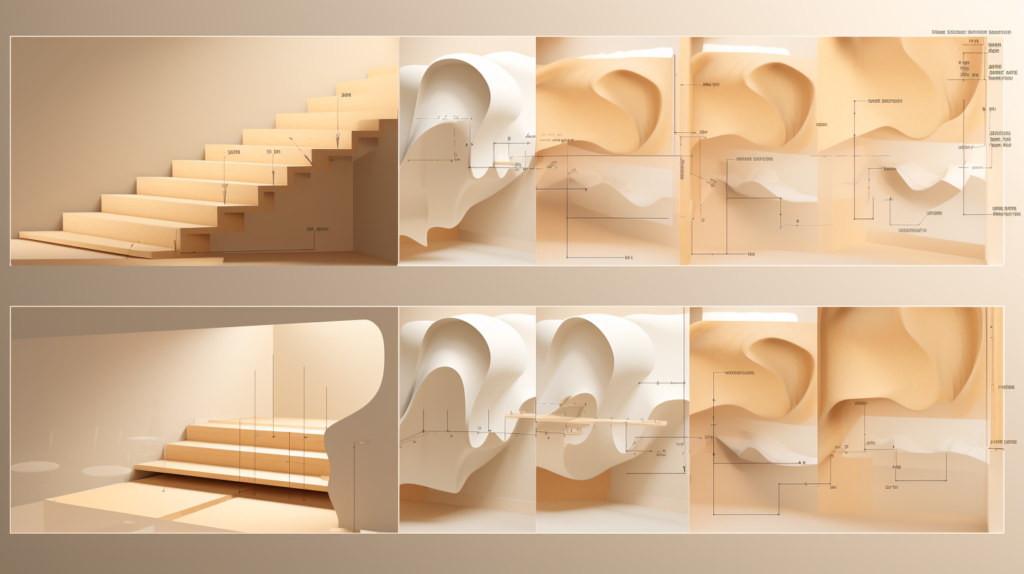The belief that bass traps can prevent your neighbor’s music from shaking your walls is widespread but misguided.
Bass traps excel in refining sound within a space, yet they fall short in actual soundproofing, which requires a different approach.
To clear the air and set the record straight, let’s dive into the effective methods for keeping bass at bay.
Understanding The Purpose Of Bass Traps

In acoustical engineering, the role of bass traps is indispensable for managing low-frequency sound energy within a room. Their primary function is to absorb excess bass that can accumulate in corners and along walls, where these frequencies naturally tend to resonate.
This phenomenon can lead to acoustic distortions such as modal resonances, which can skew the sound profile of a space, making certain bass frequencies overpowering while others may be barely audible.
The science behind bass traps lies in their ability to convert sound energy into heat through a process of friction within their absorptive material.
This is particularly important in settings where sound clarity and fidelity are of utmost importance, such as in mixing and recording studios, home cinemas, and critical listening environments.
These specialized environments benefit from the nuanced control of sound that bass traps provide, allowing for a more balanced and true-to-source audio experience.
Bass traps come in various forms and sizes, and their efficacy is influenced by their placement and the materials from which they are constructed.
Materials like rigid fiberglass, rockwool, and open-cell acoustic foam are commonly used due to their ability to trap and dissipate the energy of bass frequencies.
The placement of these traps is typically in the corners of a room—both vertical and horizontal—as these are the junctions where sound waves converge and amplify each other.
Despite their effectiveness in acoustic treatments, it’s crucial to understand that bass traps are not a panacea for all sound issues.
They are not constructed to be barriers against sound transmission, and their porous nature, which is ideal for absorbing sound, does not lend itself to blocking sound.
This distinction is often misunderstood, leading to misplaced expectations regarding the capabilities of bass traps.
Why Bass Traps Are Not Effective For Soundproofing

The concept of soundproofing is often associated with silence—creating a space that is insulated from external noise or containing the sound within a space to prevent disturbance to adjacent areas.
In residential, commercial, or industrial settings, effective soundproofing can be critical for comfort, privacy, and functionality. Soundproofing materials are therefore designed to be dense and heavy, forming a mass that sound waves cannot easily penetrate.
Bass traps, in contrast, are not designed for sound isolation. They are created to deal with the energy of sound within a room, not to prevent its escape or entry.
The materials used in bass traps are acoustically absorptive, not obstructive, meaning they can take in sound energy but are not effective at reflecting it back or stopping its passage.
This fundamental difference in design intention is what makes bass traps inappropriate for soundproofing purposes.
Another key point is that soundproofing measures need to address the full spectrum of sound transmission paths, including direct transmission through walls, ceilings, and floors, as well as flanking paths.
Flanking paths are indirect routes by which sound can bypass a sound barrier, such as through vents, ducts, or even around the barrier itself. Bass traps are not designed to seal these paths, which is essential for soundproofing.
Moreover, the nature of low-frequency sounds—those that bass traps are meant to control—presents unique challenges for soundproofing.
These sounds have long wavelengths and are able to transmit through structural elements with ease, requiring specific strategies to contain them.
This is another reason why bass traps, which handle sound within a room, fall short when it comes to preventing sound transmission into or out of a space.
Step-by-Step Guide to Soundproofing Against Bass Frequencies

Creating an environment that is insulated from the pervasive influence of bass frequencies requires a methodical and well-planned approach.
The following step-by-step guide outlines a process for enhancing the soundproofing capabilities of a wall, specifically targeting the challenging low-frequency sounds.
This method is rooted in the principles of adding mass, using sound-absorbing materials, employing decoupling techniques, and ensuring airtight sealing.
By adhering to these steps, one can effectively mitigate the transmission of unwanted bass through walls, ensuring a quieter and more peaceful space.
1. Enhancing Wall Mass for Low-Frequency Soundproofing
When it comes to constructing walls that effectively block low-frequency sounds, one of the most effective strategies is to enhance the wall’s mass from within.
This technique involves creating layers within the wall assembly that significantly increase its density, thus impeding the transmission of bass frequencies known for their ability to induce vibrations in less dense structures.
Traditional brick and concrete walls already possess substantial mass, making them naturally resistant to the passage of sound. However, they are not impervious to low-frequency penetration due to their rigid structure, which can still transfer vibrational energy.
To improve their soundproofing capabilities, additional mass in the form of dense building materials can be integrated.
2. Integrating Soundproofing Foam with Wall Studs
Incorporating soundproofing foam into wall cavities is a step that adds both mass and damping to the structure. The process begins with the installation of wall studs onto the existing brick or concrete surface.
These studs serve as the framework for holding the soundproofing material and for attaching the subsequent layers of the wall assembly.
The soundproofing foam is then placed between the studs, occupying the space within the framework. This specialized foam is designed to absorb sound waves, thereby reducing the amount of vibrational energy that can be transferred through the wall.
Its placement within the wall studs is critical, as it ensures that the foam contributes to the overall mass and dampening effect of the wall.
3. Employing Resilient Channels for Decoupling
The introduction of resilient channels is a vital component of the soundproofing system. These channels are affixed across the wall studs, creating a decoupled layer that helps to break up the path of sound transmission.
The resilient channels work by providing a flexible attachment point for the drywall, which significantly diminishes the direct transfer of vibrational energy between the wall’s outer layer and its structural components.
By installing the resilient channels, a gap is maintained between the drywall and the wall studs studs. This gap is essential for decoupling the two elements, preventing the studs from acting as conduits for sound.
The resilience of these channels plays a significant role in their effectiveness, allowing for minor movements that absorb and disrupt the transmission of low-frequency vibrations.
4. Covering with Drywall and Using Acoustic Sealant
Covering the resilient channels with drywall represents the final barrier in the soundproofing structure. The drywall sheets are carefully measured and cut to fit the wall assembly, then secured to the resilient channels.
It’s crucial that the drywall is attached to the channels rather than the studs to maintain the decoupling effect. Each sheet of drywall contributes to the wall’s mass, further enhancing its soundproofing capabilities.
The application of acoustic sealant is an essential step in ensuring the integrity of the soundproofing system. This sealant is used to fill any gaps, cracks, or seams in the drywall, as well as around the perimeter where the wall meets the floor and ceiling.
The sealant’s role is to provide an airtight barrier that prevents sound leaks, particularly for low-frequency sounds that can exploit even the smallest of openings.
Through this intricate process of integrating soundproofing foam within wall studs, installing resilient channels, covering the assembly with drywall, and meticulously sealing all potential gaps with acoustic sealant, a highly effective soundproofing barrier is created.
This barrier is specifically designed to address the challenges of low-frequency sound transmission, providing a solution that enhances the acoustic comfort of any space.
The success of this method lies in the combination of mass, damping, decoupling, and sealing—all key elements in the science of soundproofing.
When executed with precision, this approach to constructing walls can significantly reduce the intrusion of unwanted noise and create environments that are more acoustically controlled and comfortable for occupants.
Conclusion
In the effort to curtail low-frequency noise, bass traps serve an essential role in acoustic treatment but are not a standalone solution for soundproofing.
A layered approach is required, one that builds upon the mass of walls, incorporates sound-absorbing materials, employs decoupling, and ensures complete sealing.
This guide highlights a soundproofing strategy that can significantly dampen bass frequencies.
The combination of soundproofing foam within walls, resilient channels to disrupt sound paths, and the use of drywall and sealant to seal the deal, constitutes an effective barrier against intrusive noise.
Precision in installation is as important as the materials used. When these soundproofing steps are correctly implemented, they lead to quieter and more acoustically pleasing environments.
For anyone seeking to enhance the sound quality of their space, these methods offer a proven framework for achieving acoustic comfort and noise control.
